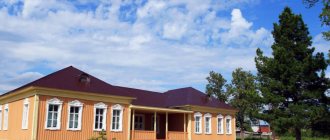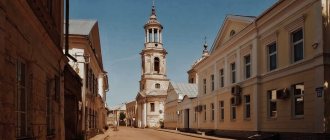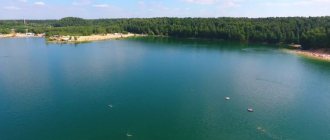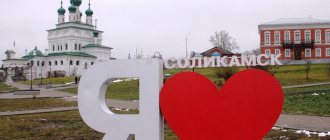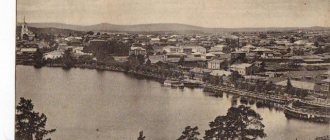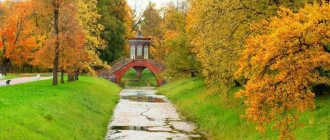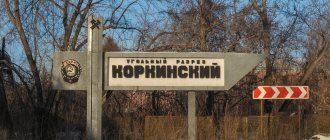Kandalaksha is the southernmost city of the Kola Peninsula. It is located beyond the Arctic Circle on the shores of the Kandalaksha Bay of the White Sea. The road to the Tersky coast, to Umba, Varzuga and Kuzomen goes through this settlement. And, in accordance with the plan of our road trip, we could not pass by this city. A short story about this northern city and the attractions in its district is in this story of mine.
Kandalaksha
What to see in Kandalaksha in one day
Officially, the founding date of Kandalaksha is 1517. In the 1920s, the village was part of the Karelian Labor Commune. In 1938, it was transferred from the KASSR to the Murmansk region, and then received the status of a city. Nowadays it is the administrative center of the Kandalaksha region, where about 30 thousand residents live. At the beginning, we collected the most interesting places in the city that are definitely worth visiting on the first day of your trip.
Kandalaksha State Reserve
- Coordinates on the map: 67.144782, 32.468857.
On an area of more than 70 hectares, two seas are adjacent - the White and Barents Sea, two regions - the Murmansk region and Karelia, two natural zones - taiga and tundra - replace each other. Kandalaksha State Nature Reserve is a unique place in all respects. It unites land and water areas characterized by a variety of flora and fauna.
Kandalaksha Bay, which is part of the reserve, is recognized as an area of international importance. The protection and use of such territories are regulated by the 1973 convention, which was signed by 170 states. It attracts tourists, among other things, thanks to the inhabitants of its waters – harp seals.
The famous scientist and children's writer, author of books about animals, Vitaly Bianki, worked in the reserve for more than 50 years. He is an honorary citizen of the city of Kandalaksha. Excursion services are organized in the reserve; a popular tourist route 3 kilometers long allows you to see a lot of interesting things.
Museum of the Kandalaksha Nature Reserve
- Address: Lineinaya street, 35.
There is a museum in the building of the Reserve Administration, opened in 1957. A visit to the museum will allow you to immerse yourself in the diverse natural world of the reserve; information about its inhabitants is clearly presented here.
Particular attention is paid to rare species of plants and animals. Among the notable exhibits are three dioramas; they are dedicated to the seabed and waterfowl living in the White and Barents Seas.
Stuffed animals are popular with both children and adults; tourists pay special attention to the elk, with whom they love to take pictures. Documentary films are shown at the museum's visitor center.
Labyrinth "Babylon"
- GPS coordinates: 67.127798, 32.439196.
Stone labyrinths are artifacts of antiquity, found in various regions of the Russian North. A similar object located just 4 km from Kandalaksha is called the “Mystery of the Kola Peninsula”. We are talking about the Babylon labyrinth. It is believed that it was built more than four thousand years ago, around 2000 BC.
The distant northern labyrinth, apparently, has nothing to do with its Mesopotamian namesake city. Why is it called Babylon? There is no consensus in the answer to this question. One version connects the name with the legendary island of Avalon from Celtic mythology, the second refers to a word from the language of the ancient Pomors, meaning “wavy”, “winding”.
The question of the purpose of labyrinths has long been the subject of debate and research. The most popular opinions are that it could either be a temple or “models of fishing traps.” Recently, science is increasingly leaning towards the “ritual” version of the purpose of labyrinths.
Museum of the History of the City of Kandalaksha
- Address: Pervomaiskaya st., 40.
The main city museum in Kandalaksha was originally a folk museum in every sense of the word. Exhibits for the museum’s collection were collected by what is called “the whole world.”
The townspeople presented gifts of household and religious objects that they had preserved, copies of documents and photographs. The museum opened its doors to visitors in 1971. After being public for three years, it turned into a branch of the Murmansk Regional Museum of Local Lore, and in 2000 it was transferred to the jurisdiction of the Kandalaksha city administration. It houses two permanent exhibitions.
The first tells about the history of the region, the culture and life of the Pomors. The second tells about the period of the Great Patriotic War. In addition, the museum regularly organizes temporary exhibitions on various topics.
Alley of Friendship
- Address: st. Alley of Friendship.
One of the symbols of modern Kandalaksha is the Alley of Friendship. The facility is very young; the development of the area between the Central Square and the embankment took place in 2017-2018. Official sources call the alley “the calling card of the city.” It is a pedestrian area with paths and places to rest.
There are various sculptures and art objects installed along the alley. Here is a gift from the Finnish sister city of Kemijärvi. The sculpture is called "Connection". Representatives of the northern neighboring country presented it to Kandalaksha on the occasion of its anniversary, because in 2022 the city celebrated its 500th anniversary.
Population
Population
| 1926 | 1933 | 1937 | 1939 | 1959 | 1970 | 1979 | 1989 | 2002 | 2010 |
| 4195 | 12 302 | 15 582 | 22 172 | 38 222 | 42 656 | 45 430 | 54 080 | 40 564 | 35 659 |
| Nationalities | 1926 | |
| number | % | |
| Total | 4195 | 100 |
| Russians | 3817 | 90,99 |
| Karelians | 104 | 2,48 |
| Finns | 8 | 0,19 |
| other | 265 | 6,32 |
Nature in the vicinity of the city of Kandalaksha
The surrounding area of Kandalaksha is full of unique natural attractions; however, even in the city itself there are several unique places that are worth visiting.
Natural complex reserve "Kaita"
- Coordinates: 66.980155, 31.525210.
The Kaita nature reserve is located on the territory of two districts of the Murmansk region - Kandalaksha and Kovdor. It was created in 2014 to preserve the biocenoses of the Kanda, Yona, and Vatsimanjoki river basins and maintain their ecological balance.
Along the banks of the rivers, relict old-age spruce trees, 200-300 years old, grow and are home to many animals listed in the Red Book. On the territory of the reserve you can pick mushrooms and berries; there are some restrictions on hunting and fishing.
Sopka Volosyanaya
- Coordinates: 67.136944, 32.518889.
Volosyanaya Hill is interesting for its ancient Sami temple, which was nicknamed “Ringing Stones”. When struck against stones, they emit a ringing sound unusual for stones and in ancient times were the object of ritual worship.
Today, geologists call such rock ultrabasite, and the unusual ringing is explained by microscopic cracks in the stones. A three-kilometer-long walking trail leads up the mountain and offers beautiful views of the city and the bay. There are different opinions regarding the origin of the name of the mountain.
According to legend, a whale once washed ashore off the coast of the hill. The Sami word for whale sounds like “walas”, hence the name. According to another version, Volosyanaya is a distortion of the word volost, i.e. mountain belonging to the volost government.
Granitoids of Mikkov Island
- Coordinates: 66.706207, 33.011705.
Mikkov Island is located in the waters of the Bolshaya Kovda Bay in the Kandalaksha Bay of the White Sea. It is separated from the continent by an impressive distance of 4,5 thousand kilometers. This uninhabited island appeared on the tourist radar thanks to a geological natural monument of regional significance.
In its northeastern part you can see natural outcrops of granitoids - rocks of igneous origin, which are approximately 2.3 billion years old.
Okatievo Mountain and Iron Gate Gorge
- Coordinates: 66.795560, 31.531236.
A natural object closely connected with the ancient Sami period of the history of these places. It is considered an ancient monument. According to scientists, from a historical point of view, it would be more correct to call Mount Akatieva, but in modern Russian toponymy the option beginning with the letter O has become entrenched.
The fact is that the name of the mountain is associated with the ancient Sami word “Akka”. Literally translated, it means “old woman.” The Sami called the highest female deity that way. They believed that the goddess lived in a sacred gorge adjacent to the mountain. This 150-meter mountain corridor is today known as the Iron Gate. According to Sami beliefs, the gorge has magical powers; you need to behave quietly here so as not to anger the deity.
Silver mine on Medvezhy Island
- Coordinates: 66.995679, 32.666624.
Since the time of Anna Ioannovna, the precious metal silver has been mined in the territory of the present Kandalaksha region. The mine, located on Medvezhy Island, became one of the first developed silver deposits in Russia.
It officially began to function in 1732 after the corresponding decree of the Empress, although local residents have known about the presence of silver on the island since time immemorial.
A detailed description of the deposit was given in one of his works by M.V. Lomonosov. Four years after the discovery of the deposit, the first domestic silver ruble was minted from the local metal.
Mouth of the Niva River
- Coordinates: 67.133780, 32.423252.
The city of Kandalaksha stands between two famous bodies of water - the White Sea and Lake Imandra, at the mouth of the Niva River. The name of the 36-kilometer-long water artery evokes associations with the famous Soviet car and is only one letter different from the main river of St. Petersburg, but this body of water has nothing to do with either one.
There are different versions about the origin of the hydronym. It is traced back to the Sami word for fast, and to the Pomeranian name for a river rapid. It turns out that the name speaks for itself, because the river is really rapids and is used for rafting. The Niva River, which you can meet in Kandalaksha, should also not be confused with the river of the same name in the Kondopoga region of Karelia.
Therapeutic mud of Palkina Lipa
- Coordinates: 67.062575, 32.289436.
The nature of the Arctic not only amazes with its harsh and beautiful views, but also allows you to relax and improve your health. One of the attractions born of Mother Nature is the healing mud in the shallow waters of Palkina Guba. These places are also called the “Golden Mine”, “Territory of Health”.
The nearest settlement is a small village called White Sea. The healing properties of mud were officially confirmed in 1974. They are used for treatment in medical institutions of the Murmansk region.
Climate
Kandalaksha is located significantly south of Murmansk, however, due to its location far from the Barents Sea, its climate is more continental, and is transitional from temperate to subarctic. Summer is very short, cool, winter is colder than in Murmansk, but less snowy, but still protracted. Spring begins only at the end of April, winter begins at the end of October. The minimum temperature of −43.5 °C was recorded in Kandalaksha on January 8, 1985, the maximum temperature was +32 °C on August 1, 2022.
- Average annual air temperature - 0.4 °C
- Relative air humidity - 80%
- Average wind speed - 2.6 m/s
Historical places of Kandalaksha
There are many places of historical significance in this town of the Murmansk region that will tell you a lot of interesting things about the past of the region.
Monastic curtain
- Coordinates: 67.129444, 32.425000.
At the mouth of the Niva River there is a historical place called Monastyrsky Navolok. Navolok is the name given to a long cape protruding into the sea, and it is called Monastyrsky because in the 16th century there stood the monastery of the Nativity of the Blessed Virgin Mary, founded by Theodoret of Kola. It existed for almost two hundred years - from 1548 to 1742.
In 1589, the monastery was destroyed by the Swedes, but was rebuilt and revived. With the flourishing of the Solovetsky Monastery, this monastery fell into decay. In 2003, on the site where there once was a church altar, a Worship Cross was installed, reminiscent of the destruction of the monastery in 1589.
One of the first Pomeranian cemeteries, Kandalaksha, is located on Monastyrskoye Navoloko. It became the scenery for the filming of Nikolai Dostal's film "Raskol". Archpriest Avvakum, to whom the film is dedicated, was indeed in exile in the Kandalaksha Monastery. Excursions to the canopy are organized by employees of the Kandalaksha History Museum.
Old Kandalaksha
- Coordinates: 67.133523, 32.419581.
This is the name of the territory on both sides of the Niva River, where the ancient Pomeranian village was located. It is considered the “historical part” of the city. Modernity with its new buildings has hardly touched these places. Urban areas, built already in the 20th century, are located in the distance. Examples of Pomeranian architecture from past centuries have been preserved here.
Old Kandalaksha consists of two parts, separated by a river. The left bank region is called “Lower Kandalaksha”, and the right bank region is called “Japan”. Why did part of the northern village borrow its name from the eastern country? The answer to this question is this: the residents of Kandalaksha, who participated in the war with the Japanese in 1904-1905, returned from the battlefields and christened their area that way.
Seydy
- Coordinates: 67.134335, 32.458426.
Seids are large boulders placed on smaller stones and standing on them as if on legs. Such designs could be created both by nature and by man. For the ancient Sami, these stones were an object of cult; they believed that the spirit of a shaman moved into the stone after death, and therefore the boulders were considered sacred.
There is also a version about the pre-Sami origin of the seids. Some scientists believe that this is the legacy of the ancient Arctic civilization. On the Kola Peninsula, seids can be found in several places, including on the hills in the vicinity of Kandalaksha.
Late Neolithic site
- Coordinates: 67.116512, 32.478907.
Opposite Maly Pitkul in the suburbs of Kandalaksha there is an archaeological site - the site of an ancient man of the Neolithic era dating back to the 2nd millennium BC. A feature of the Neolithic on the Kola Peninsula is flat-bottomed ceramic ware. This one was found just at the excavations near Kandalaksha. This archaeological site is a cultural heritage site of regional significance.
Transport
Within the city limits there is the Kandalaksha station, which belongs to the Murmansk region of the Oktyabrskaya Railway. From the station's station you can get direct access to Murmansk, Moscow, St. Petersburg and other Russian cities. In summer, direct passenger trains run to Anapa, Adler and Novorossiysk. In addition, international passenger traffic from Murmansk to Minsk passes through Kandalaksha.
City and suburban transport of the city is represented by buses and minibuses: 3 city bus routes and 3 suburban bus routes to Lupche-Savino-2, White Sea and Kolvitsa. From Kandalaksha, intercity passenger transportation is carried out to Murmansk, Polyarnye Zori, Umba and Varzuga, as well as to the centers of municipalities of the Kandalaksha region: Zelenoborsky, Alakurtti and Zarechensk.
Interesting temples of the Kandalaksha region
Kandalaksha and its surroundings are also not short of beautiful churches and temples - there are truly unique and truly holy places of pilgrimage here.
Church of the Nativity of John the Baptist
- Address: Rechnaya st., 1A.
The current functioning Orthodox church in Nizhnyaya Kandalaksha is a remake from 2005, but there is an interesting backstory behind it that is almost five centuries long. The first church on this site was built back in 1523 by Archimandrite Theodoret of Kola. During its history, the church, around which the monastery then arose, was destroyed and rebuilt several times.
After the abolition of the monastery, a new one was erected on the site of the old, dilapidated church. Its construction was completed in 1801. But this religious building has not survived to this day. The temple was destroyed during the anti-religious campaign of 1940. The 21st century church standing on this site is a kind of tribute to the memory of the monastery and the history of local Orthodox culture.
St. Nicholas Church in the village. Kovda
- Address: Zarechnaya st., 8, Kovda village.
In the village of Kovda near Kandalaksha, a monument of wooden architecture has been preserved - St. Nicholas Church, dating back to the 17th century. This characteristic single-domed church of the cage type with a gable roof forms an ensemble together with a bell tower built a century later.
History shows that this construction was preceded by another, more ancient temple, which has been known since the 15th century. It is noteworthy as the only object of its kind preserved on the territory of the modern Murmansk region.
Bottom line
Kandalaksha as a settlement arose on the site of a fishermen's camp, a church and a monastery, then became a railway junction, and turned into a city thanks to the construction of a hydroelectric power station and an aluminum plant. At its peak, the population of Kandalaksha exceeded 54 thousand people, but over the past 25 years it has been declining - and today about 30 thousand live there. The city depends on a railway depot, a port and an aluminum smelter. It requires improvements in terms of infrastructure and housing stock. And he needs to look for ways to at least save people.
The most famous monuments of the city of Kandalaksha
Several famous sculptural compositions and memorial monuments are also worth pointing out when considering the sights of Kandalaksha.
Monument to Gregory the Seal
- Address: 50th Anniversary of October Street.
One of the first to appear on Friendship Alley was an interesting city sculpture depicting an aquatic mammal – the harp seal. These animals live in Kandalaksha Bay and attract the attention of citizens and tourists, and therefore the appearance of a monument in the city is quite logical. The animal even has a name - Gregory. It was sculpted by sculptor Valentin Myzdrikov. It was installed in December 2022.
Monument to A.V. Spekov
- Address: corner of Spekova and Sovetskaya streets.
Border guard, Hero of the Soviet Union Alexander Vasilyevich Spekov, a participant in the Soviet-Finnish War, died in battle in 1940, fighting to the last bullet, and was buried near the village of Kuolayarvi, Kandalaksha region.
And in the city itself in 1959, a monument was erected to him, the only one in the country. The full-length figure of a Soviet border guard is cast from bronze and mounted on a granite pedestal. The author of the monument is Svetlana Ostrovskaya.
Monument to the victims of the intervention of 1918-1920.
- Address: Zarechnaya street.
As is known, during the Civil War, foreign interventionists provided assistance to the white movement. They landed on the Kola Peninsula, occupying its territory. A monument in honor of the victims of this period, which is a stele in white and red tones, topped with a five-pointed star, was erected in the center of Kandalaksha in the 1930s.
Later, the modest monument was moved to the Monastyrsky Navolok, where it remains to this day. The monument, which is an object of cultural heritage of regional significance, now requires restoration.
Monument Tank T-34
- Address: Central Square.
T-34 is a legendary Soviet tank, a participant in the battles of the Great Patriotic War. In Kandalaksha it can be seen in the very center of the city. And this is not some kind of model, but a real combat vehicle that took part in battles.
In the summer of 1941, fierce tank battles took place in the Kandalaksha area. “Glory to the heroes - the defenders of the northern Arctic” - this is the inscription made on the pedestal where a direct participant in the events was placed.
Worship cross on Mount Krestovaya
- Coordinates: 67.127279, 32.471752.
Local residents claim that the cross on the mountain was erected by Theodoret of Kola in the 16th century. In 1915 it was destroyed by a storm, and in 2006 it was restored. The height of the cross is 5 meters, weight is 170 kg.
Steam Locomotive Monument
- Address: Lokomotivnaya street.
A real locomotive placed at the railway station in 1984 serves as a monument to the railway workers who gave their lives during the Great Patriotic War. True, this particular locomotive is not a witness to the war. It was made in Ulan-Ude 3 years after the victory. However, it became a symbol of memory of the terrible war.
Boat "Storm"
- Address: Belomorskaya street.
The Kandalaksha sea trade port arose back in 1915. In 2010, on Belomorskaya Street the boat “Storm” found its permanent home, becoming a monument testifying to the maritime status of the city.
War Memorial
- Address: Memory Alley.
The military memorial at the old cemetery in Kandalaksha was opened in 2007. The authors of the composition are local artist Andrey Yushkov and Murmansk sculptor Alexander Arsentyev. In the center of the memorial there is a figure of a soldier standing against the background of an image of the Order of Victory, on the sides there are granite slabs with the names of the city’s defenders who died during the war.
Industry
Hydroelectric power, shipping, railways and aluminum are the main pillars on which the city rests.
Since 1915, the port of Kandalaksha has been operating, which has access to the country’s major highways thanks to railway and road access, and a locomotive depot - cars from America and Great Britain were assembled there more than 100 years ago.
Since the 1930s, the NIVA HPP-2 hydroelectric power station has been operating, which was supposed to become the energy center of the region and the base for the creation of the Kola energy system. It was built without experience in the difficult conditions of the Far North by the hands of 1,200 dispossessed peasants, prisoners from the Solovetsky camp. Today it produces 365 million kWh per year.
In 1951, the first aluminum was produced at the Kandalaksha Aluminum Plant. This is the only aluminum smelter in the world beyond the Arctic Circle. Its products are used in the electrical industry; its capacity is 72 thousand tons of aluminum per year.
Entertainment for children and recreation in Kandalaksha
For recreation near Kandalaksha, there are several interesting vacation spots where it will be convenient to come even with children.
Recreation center "Kanda-Viking"
- Address: Kandalaksha district, R-21 Kola, 1138th kilometer.
Sports and outdoor enthusiasts will find something to do in Kandalaksha. There are many recreation centers and tourist complexes here. And the landscape of the Kola Peninsula makes these places popular for skiers.
One of the places where such tourists will be comfortable and interesting is the Kanda-Viking camp site. It offers downhill skiing and regular relaxing skiing, as well as going on safari or playing a variety of sports games.
Kandalaksha Yacht Club
- Address: Rechnaya street.
Take a yacht ride through the waters of the White Sea to feel all its power, meet seals - what could be better? This opportunity will be provided by the local yacht club, created as a public organization in 2010. On the territory of the yacht club there is the possibility of accommodation in rooms or at a campsite. The restaurant “Prichal No. 11” is at guests' disposal.
Recreation center "Sandy Coast"
- Coordinates: 67.085620, 33.264958.
A relaxing holiday in nature, the opportunity to relax in the bathhouse and enjoy the purity of the forest air, go boating on the waters of Lake Kolvitsa, play billiards - all this is available to guests of the Sandy Coast camp site, located along the highway from Kandalaksha to the village of Umba.
How to get there?
By car, you should take the M18 Kola highway to Kandalaksha.
From St. Petersburg - 1101 km (via Kirovsk, Priladozhsky, Pryazha, Kovdovskoye). In the first case, the journey will take 19 hours, in the second - 12. The distance from Kandalaksha to Murmansk is 244 km.
Trains and electric trains run in the direction Kandalaksha-Polar Circle. By train it will take 2 hours 17 minutes, by train - 2 hours 42 minutes. This option is more budget friendly.
You can view the train schedule from Murmansk here:
Sport
Sports objects
- Palace of Sports
- Swimming pool
- Lokomotiv Stadium"
- Ski slopes
- Ski complex "Mount Krestovaya"
- Kandalaksha Yacht Club
- GTO site
- Sports ground "Anchovy and Kuzya"
- Palace of Sports
- Pool
- Mount Krestovaya
- GTO site
Sports schools
Naturban sports school
In Kandalaksha, naturban as a sport appeared in 1985, when a sports section was organized on the basis of the city vocational school, and on January 1, 1990, a city specialized children's and youth sports school for luge was opened, which became the only school in the North-West of Russia. In 1993, for the training of highly qualified athletes - candidates for the Russian national natural team team, the institution was granted the status of an Olympic reserve school.
Seven times (2002, 2004, 2006, 2008, 2010, 2013,2017) the Kandalaksha naturban school became the leader in the regional competition for the best institution of additional education for children with a sports focus. In 2016, the school won a silver award.
For high achievements in the field of sports, the preparation of a sports reserve for the Russian national team in natural sports, the team of the sports school for natural sports in the city of Kandalaksha was awarded a certificate of participation in the Federal Register “All-Russian Book of Honor” in 2009, and in 2011 - for a significant contribution to the development of physical education and sports movement, the school received a certificate from the National Register of “Leading Educational Institutions of Russia.”
More than 50% of the Russian national team consists of students from the Kandalaksha Naturban school. Since 1998, in official international competitions: championships, championships, World and European Cups, the Naturban school athletes, as part of the Russian Federation national team, have won more than 380 medals of the highest standard.


